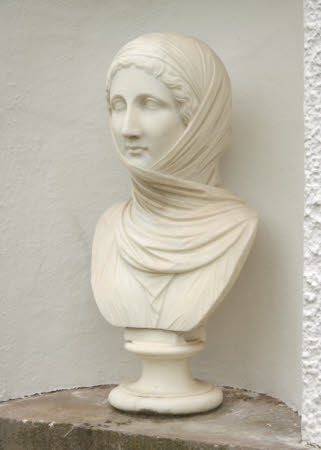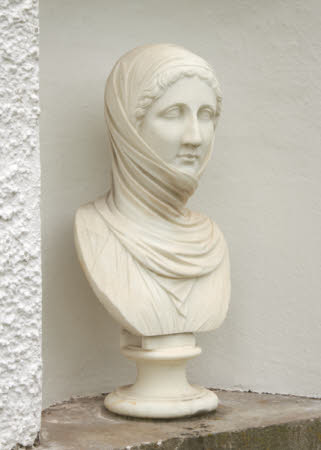A bust of a woman, known as a Vestal Virgin or as the Zingarella, displayed as an allegory of Winter
Unknown
Category
Art / Sculpture
Date
c. 1780 - 1800
Materials
Marble bust on marble socle
Measurements
635 x 320 x 240 mm
Place of origin
Italy
Order this imageCollection
Ardress House, County Armagh
NT 247725.1
Summary
Sculpture, marble; Portrait bust of a woman, known as a Vestal Virgin or as the Zingarella, after an antique model; probably Italian; c. 1780-1800. A marble copy of a Hellenistic marble head now in the Museo Archeologico Nazionale in Naples, formerly identified as a Vestal Virgin, and otherwise popularly known as the Zingarella (‘Gipsy Girl’). Displayed at Ardress as ‘Winter’, within a group of four heads depicting the Seasons.
Full description
A marble head of a young woman, looking ahead, hair parted in the middle, wearing a tunic and over her head the top of a mantle, known as an ampechonion, tightly wrapped around her head and her neck. Bust section in herm form. On a turned marble socle. A copy of a once-celebrated Hellenistic marble bust from the Farnese collection, now in the Museo Archeologico Nazionale in Naples (Inv. 6194; Gasparri 2009, I, pp. 203-205, no. 95 (Stefania Pafumi); Omar Cucciniello and Paola Zatti, eds., Canova. I volti ideali, exh. cat., Galleria d’arte Moderna, Milan 2019, pp. 160-61, no. 3.1). Probably acquired by the Farnese family in the sixteenth century, the head was first certainly recorded in an inventory of Palazzo Farnese in Rome in 1644. It was restored in 1786 in the Roman workshop of Carlo Albacini, before it was transferred with the remainder of the Farnese collections from Rome to Naples. The sculpture was much admired by visitors to Rome in the seventeenth and eighteenth centuries, the British traveller Edward Wright describing it as ‘a Vestal Virgin of exquisite beauty’ (Wright 1730, I, p. 285). The German classical art historian Johann Joachim Winkelmann (1717-68) questioned whether the traditional identification of the sculpture as a Vestal Virgin, a Roman priestess, was in fact correct. It has also been popularly known as the Zingarella (‘the gipsy girl’) because of its generic resemblance to two restored antique sculptures of women from the Borghese collection, one now in the Musée du Louvre in Paris (on deposit at Versailles) and the other still in the Galleria Borghese in Rome. Both have bronze heads and other additions that are generally attributed to the French sculptor Nicolas Cordier (1567-1612), who worked in Rome, and they have long been popularly known as the Zingara (‘the gipsy woman’). The head was much copied in the eighteenth century and seems to have enjoyed special popularity with the British and Irish. An early eighteenth-century drawing in the Topham collection at Eton College (Inv. Bm7.7) suggests that Albacini’s restorations were minimal. There is another marble copy at Stourhead (NT 732909), currently attributed to Christopher Hewetson (c. 1736-98), the Irish sculptor who worked in Rome for most of his career. Plaster copies are at Mount Stewart (NT 1220125.2) and at West Wycombe Park (NT 807688.1). Beyond National Trust properties, there are copies at Broadlands (Dagmar Grassinger, Antike Marmorskulpturen auf Schloß Broadlands (Hampshire), Mainz am Rhein 1994, pp. 106-07, no. 106-07, no. 34). and at Lydiard Park, Swindon (Inv. LYD1993-90-1), attributed to John Cheere (1709-87). Both the Stourhead and West Wycombe heads are paired with a head of the Zingara, based on Cordier’s sculpture at Versailles. It is by no means clear that Cheere did make copies of the Farnese bust, and certainly the great majority of eighteenth-century copies of the Zingara made in England by him and by Peter Scheemakers (1691-1781) appear to have been after the Cordier model, rather than the head in Naples. In the early nineteenth century, however, this beautiful model inspired Antonio Canova (1757-1822) to make a series of similar heads of Vestals (Omar Cucciniello and Paola Zatti, nos. 3.4-3.6). The version at Ardress is one of four sculptures of females (NT 247725.1-4) set in niches on the Garden Front of the house, which was redesigned by the second George Ensor (1772-1845). He may be presumed to have acquired the busts and to have installed them as part of the remodelling, but it is not known when and from where they came into his possession. They have long been presented as allegories of the Seasons: Spring, Summer, Autumn and Winter, and all four have hitherto been attributed to Christopher Hewetson, although in fact only the sculpture described as ‘Spring’, a portrait of an unknown woman (NT 247725.4), is signed by him, whilst the bust of ‘Summer’ has nothing to do with Hewetson and seems to be an invented modern work (NT 247725.3). The bust known as ‘Autumn’ (NT 247725.2) may on the other hand be recorded in the inventory drawn up after the sculptor’s death in 1798, which shows that alongside his successful business making portrait busts, Christopher Hewetson also produced significant numbers of copies after antique sculptures. It is possible that he made the copy of the Zingarella at Ardress but, since this model is not specifically recorded in the inventory, this must remain uncertain. Jeremy Warren June 2022
Provenance
Presumably acquired by George Ensor (1772-1845).
Makers and roles
Unknown, sculptor Christopher Hewetson (Thomastown c. 1736 - Rome 1798), sculptor
References
Wright, Edward, Esq. Some observations made in travelling through France, Italy, &c. in the years 1720, 1721, and 1722. M.DCC.XXX. [1730]., I, p. 285. Gasparri 2009: Carlo Gasparri, ed., Le sculture Farnese, 3 vols., Milan 2009., I, pp. 203-205, no. 95. Suárez Huerta 2014: Ana María Suárez Huerta, ‘Will and Inventory of Christopher Hewetson (c1737–1798)’, The British Art Journal, 15, no. 2 (2014), pp. 3-17, p. 7.



